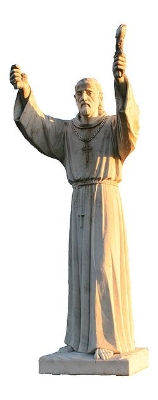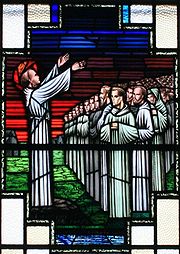
Finnian of Clonard
Encyclopedia
Saint Finnian of Clonard ('Cluain Eraird'), or Finian, 'Fionán' or 'Fionnán' in Irish, (470 - 549) was one of the early Irish monastic
saint
s, who founded Clonard Abbey
in modern-day County Meath
. The Twelve Apostles of Ireland
studied under him. Saint Finnian of Clonard (along with Saint Enda of Aran
) is considered one of the fathers of Irish monasticism.
at Llancarfan, Glamorganshire.
 After a long sojourn there, of thirty years according to the Codex Salmanticensis
After a long sojourn there, of thirty years according to the Codex Salmanticensis
Life, he returned to his native land and went about from place to place, preaching, teaching, and founding churches, most noticeably at Skellig Michael
or Great Skellig eight miles off the coast of County Kerry
, Ireland
, which is a UNESCO
World Hertitage Site. His first monastery was at Aghowle, County Wicklow. Around 520, he was at last led by an angel to Cluain Eraird (Clonard, County Meath) on the River Boyne, which he was told would be the place of his resurrection. Here he built a little cell and a church of clay and wattle, which after some time gave way to a substantial stone structure, and entered on a life of study, mortification, and prayer. The fame of his learning and sanctity was soon noised abroad, and scholars of all ages flocked from every side to his monastic retreat—young laymen and clerics, abbots, and bishops.
had begun. With the transference by the Norman
Bishop of Rochfort, in 1206, of the See of Meath
from Clonard to Trim
, the glory of the former place departed forever.
St Finnian of Clonard's feast-day is 12 December.
Celtic Christianity
Celtic Christianity or Insular Christianity refers broadly to certain features of Christianity that were common, or held to be common, across the Celtic-speaking world during the Early Middle Ages...
saint
Saint
A saint is a holy person. In various religions, saints are people who are believed to have exceptional holiness.In Christian usage, "saint" refers to any believer who is "in Christ", and in whom Christ dwells, whether in heaven or in earth...
s, who founded Clonard Abbey
Clonard Abbey
Clonard Abbey was an early medieval monastery situated on the River Boyne, just beside the traditional boundary line of the northern and southern halves of Ireland in modern County Meath...
in modern-day County Meath
County Meath
County Meath is a county in Ireland. It is part of the Mid-East Region and is also located in the province of Leinster. It is named after the ancient Kingdom of Mide . Meath County Council is the local authority for the county...
. The Twelve Apostles of Ireland
Twelve Apostles of Ireland
The Twelve Apostles of Ireland were twelve early Irish monastic saints of the sixth century who studied under St Finian at his famous monastic school Clonard Abbey at Cluain-Eraird , now Clonard in County Meath.-Dá apstol décc na hÉrenn:The twelve saints are grouped together as such in the text Dá...
studied under him. Saint Finnian of Clonard (along with Saint Enda of Aran
Enda of Aran
Saint Enda of Aran is an Irish saint in the Roman Catholic Church. His feast day is March 21.-Overview:...
) is considered one of the fathers of Irish monasticism.
Life
Finnian was born at Myshall, County Carlow. His father was Rudraigh, an Ulster noble; his mother, Telach of Leinster. At an early age he was supposedly placed under the care of St. Fortchern, by whose direction, it is said, he proceeded to Wales to perfect himself in holiness and sacred knowledge under the great saints of that country. He is said to have studied under Sain CadocCadoc
Saint Cadoc , Abbot of Llancarfan, was one of the 6th century British Christian saints. His vita twice mentions King Arthur. The Abbey of Llancarfan, near Cowbridge in Glamorganshire, which he founded circa 518, became famous as a centre of learning...
at Llancarfan, Glamorganshire.
Foundations

Codex Salmanticensis
The Codex Salmanticensis is a medieval Irish manuscript containing an extensive collection of Irish saints' Lives, now in the Royal Library of Belgium in Brussels...
Life, he returned to his native land and went about from place to place, preaching, teaching, and founding churches, most noticeably at Skellig Michael
Skellig Michael
Skellig Michael , also known as Great Skellig, is a steep rocky island in the Atlantic Ocean about 9 miles from the coast of County Kerry, Ireland. It is the larger of the two Skellig Islands...
or Great Skellig eight miles off the coast of County Kerry
County Kerry
Kerry means the "people of Ciar" which was the name of the pre-Gaelic tribe who lived in part of the present county. The legendary founder of the tribe was Ciar, son of Fergus mac Róich. In Old Irish "Ciar" meant black or dark brown, and the word continues in use in modern Irish as an adjective...
, Ireland
Ireland
Ireland is an island to the northwest of continental Europe. It is the third-largest island in Europe and the twentieth-largest island on Earth...
, which is a UNESCO
UNESCO
The United Nations Educational, Scientific and Cultural Organization is a specialized agency of the United Nations...
World Hertitage Site. His first monastery was at Aghowle, County Wicklow. Around 520, he was at last led by an angel to Cluain Eraird (Clonard, County Meath) on the River Boyne, which he was told would be the place of his resurrection. Here he built a little cell and a church of clay and wattle, which after some time gave way to a substantial stone structure, and entered on a life of study, mortification, and prayer. The fame of his learning and sanctity was soon noised abroad, and scholars of all ages flocked from every side to his monastic retreat—young laymen and clerics, abbots, and bishops.
Veneration
In the Office of St. Finnian it is stated that there were no fewer than 3000 pupils getting instruction at one time in the school in the green fields of Clonard. The master excelled in exposition of the Sacred Scriptures, and to this fact must be mainly attributed the extraordinary popularity which his lectures enjoyed. The exact date of the saint's death is uncertain, but he probably died of plague in 549. His burial-place is in his own church of Clonard. Clonard became an important school because of the number of its students who went on to found other monasteries. For centuries after his death the school continued to be renowned as a seat of Scriptural learning, but it suffered at the hands of the Danes, especially in the eleventh century, and two Irishmen, O'Rorke of Breifney and Dermod McMurrough, helped to complete the work which the NorthmenViking
The term Viking is customarily used to refer to the Norse explorers, warriors, merchants, and pirates who raided, traded, explored and settled in wide areas of Europe, Asia and the North Atlantic islands from the late 8th to the mid-11th century.These Norsemen used their famed longships to...
had begun. With the transference by the Norman
Normans
The Normans were the people who gave their name to Normandy, a region in northern France. They were descended from Norse Viking conquerors of the territory and the native population of Frankish and Gallo-Roman stock...
Bishop of Rochfort, in 1206, of the See of Meath
Roman Catholic Diocese of Meath
The Diocese of Meath is a Roman Catholic diocese in eastern Ireland. It is one of eight suffragan dioceses which are subject to the Metropolitan Archdiocese of Armagh...
from Clonard to Trim
Trim, County Meath
Trim is the traditional county town of County Meath in Ireland, although the county town is now Navan. The town was recorded in the 2006 census to have a population of 6,870....
, the glory of the former place departed forever.
St Finnian of Clonard's feast-day is 12 December.
Secondary sources
- Hughes, Kathleen. "The Cult of St Finnian of Clonard from the Eighth to the Eleventh Century." Irish Historical Studies 9.33 (1954). pp. 13–27.
Primary sources
- Lives of St Finnian of Clonard
- Irish Life, ed. Whitley Stokes, Lives of the Saints from the Book of Lismore. Oxford, 1890. Vol. 2.
- Latin Life in the Codex SalmanticensisCodex SalmanticensisThe Codex Salmanticensis is a medieval Irish manuscript containing an extensive collection of Irish saints' Lives, now in the Royal Library of Belgium in Brussels...
(fos. 83r-86v), ed. J. De Smedt and C. De Backer, Acta Sanctorum Hiberniae ex codice Salmanticensi. Edinburgh et al., 1888. Cols 189-210. - Latin Life in Bodleian, Rawlinson MS B 485 (fos. 54-8), and Rawlinson B 505 (fos. 156v-160v). Unpublished.
External links
- Catholic Encyclopedia - School of Clonard

